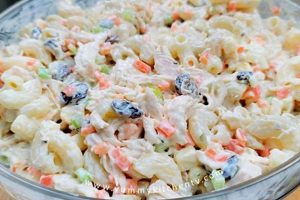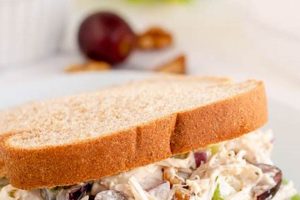A dish composed of cooked chicken, kale, and various other ingredients combined to create a nutritious and flavorful meal. These additional components can include vegetables like bell peppers, onions, and tomatoes; fruits such as dried cranberries or apples; nuts and seeds for added texture and healthy fats; and a dressing to bind the ingredients and enhance the taste. Variations exist using different cooking methods for the chicken (grilled, roasted, or shredded) and different types of kale (curly, lacinato, or baby).
This type of salad offers a balance of protein, vitamins, and fiber, making it a healthy meal option. Kale, a nutrient-dense leafy green, provides vitamins A, C, and K, while chicken contributes lean protein. The inclusion of other vegetables and fruits further enhances the nutritional value. Such salads are a versatile dish suitable for various dietary preferences, adaptable to different flavor profiles and customizable to individual needs. Its popularity stems from its ease of preparation and adaptability to seasonal ingredients.
The following sections will delve into specific ingredient selections, preparation techniques, and variations to guide the creation of a delicious and satisfying meal.
Tips for a Delicious and Nutritious Kale and Chicken Salad
Creating a satisfying and healthy salad involves careful consideration of ingredients and preparation techniques. These tips offer guidance for maximizing flavor and nutritional value.
Tip 1: Massage the Kale: Massaging kale leaves with a small amount of olive oil and lemon juice or vinegar tenderizes the leaves, reducing their bitterness and making them more palatable.
Tip 2: Choose the Right Chicken: Grilled or roasted chicken breast provides lean protein and complements the kale’s flavor. Shredded rotisserie chicken offers a convenient alternative.
Tip 3: Diversify with Vegetables: Incorporating a variety of vegetables adds texture, flavor, and nutrients. Consider bell peppers, red onion, shredded carrots, or chopped cucumbers.
Tip 4: Add Healthy Fats: Nuts and seeds contribute healthy fats, fiber, and satisfying crunch. Almonds, walnuts, sunflower seeds, or pumpkin seeds are excellent choices.
Tip 5: Enhance with Fruit: Dried cranberries, chopped apples, or mandarin orange segments provide a touch of sweetness and complement the savory elements.
Tip 6: Select a Flavorful Dressing: A light vinaigrette, such as lemon-tahini or balsamic vinaigrette, enhances the salad’s flavors without overpowering the other ingredients. Avoid creamy dressings that can mask the kale’s freshness.
Tip 7: Don’t Overdress: Add dressing just before serving to prevent the salad from becoming soggy. Start with a small amount and add more as needed.
By following these tips, one can achieve a balanced and flavorful salad that provides both nutritional benefits and culinary satisfaction.
These guidelines offer a starting point for creating a personalized salad experience. Experimentation with different ingredients and flavors allows for the discovery of unique and enjoyable combinations.
1. Ingredients
Ingredient selection significantly impacts the overall quality, nutritional value, and flavor profile of a chicken and kale salad. Careful consideration of each component contributes to a balanced and satisfying meal. Fresh, high-quality ingredients are essential. For example, choosing vibrant, crisp kale over wilted leaves ensures optimal texture and flavor. Opting for lean protein sources, such as grilled or baked chicken breast, contributes to the salad’s healthfulness.
The interplay of ingredients creates complex flavors and textures. The slight bitterness of kale is balanced by the savory chicken and the addition of complementary ingredients. Acidic elements, such as lemon juice or vinegar in the dressing, brighten the flavors and tenderize the kale. Sweet additions, like dried cranberries or chopped apple, provide contrasting notes. Textural variety can be achieved through the inclusion of crunchy nuts, seeds, or croutons. Understanding these interactions allows for informed ingredient choices tailored to individual preferences.
Strategic ingredient selection allows for customization based on dietary needs and preferences. Vegetarian adaptations can utilize grilled tofu or chickpeas as protein alternatives. Individuals seeking lower carbohydrate options can reduce or eliminate high-starch vegetables. Food allergies or intolerances can be accommodated by substituting ingredients. Awareness of ingredient interactions and potential substitutions empowers individuals to create personalized and satisfying salads that align with their specific requirements. Ultimately, the choice of ingredients determines the final outcome of the salad, influencing its nutritional content, taste, and overall appeal.
2. Preparation
Preparation methods significantly influence the final quality and palatability of a chicken and kale salad. Proper techniques enhance flavor, optimize texture, and ensure food safety. The following facets highlight key aspects of preparation.
- Kale Preparation
Kale’s inherent texture requires specific handling. Massaging the leaves with olive oil and a bit of acid, such as lemon juice or vinegar, tenderizes the fibers and reduces bitterness. This step improves both palatability and digestibility. Chopping or tearing the leaves into bite-sized pieces further enhances the eating experience.
- Chicken Preparation
Chicken can be prepared in various ways, each impacting the salad’s overall flavor profile. Grilling or roasting imparts a smoky char, while poaching or baking results in a more neutral flavor. Pre-cooked chicken, such as rotisserie chicken, offers convenience. Ensuring the chicken is cooked thoroughly to a safe internal temperature is crucial for food safety.
- Ingredient Combination
The order in which ingredients are combined affects the salad’s final texture and flavor. Adding dressing too early can lead to soggy leaves. Incorporating ingredients with higher water content, such as tomatoes or cucumbers, closer to serving time helps maintain crispness. Strategic layering of ingredients can also create visually appealing presentations.
- Dressing Preparation and Application
The choice and application of dressing play a vital role in the overall balance of flavors. A light vinaigrette complements the kale’s earthiness without overpowering other ingredients. Creamy dressings, while palatable, can weigh down the salad. Adding the dressing just before serving prevents the leaves from wilting and maintains a desirable texture.
These preparation steps contribute to a successful and enjoyable chicken and kale salad. Attention to detail in each stage ensures a flavorful, nutritious, and texturally pleasing meal.
3. Nutritional Value
Nutritional value represents a cornerstone of a well-composed chicken and kale salad recipe. This value derives from the inherent properties of the core ingredients and their synergistic interactions. Kale, a nutritional powerhouse, contributes vitamins A, C, and K, alongside minerals like calcium and potassium. Chicken provides lean protein, essential for muscle building and repair. The combined effect offers a balanced nutritional profile, beneficial for overall health and well-being. Consider a salad with grilled chicken, kale, bell peppers, and a lemon-tahini dressing. This combination offers a complete protein source, antioxidants from the vegetables, and healthy fats from the dressing.
The nutritional density of this salad type makes it an ideal choice for various dietary goals. Its high fiber content supports digestive health and promotes satiety. The low calorie density, coupled with high nutrient content, makes it suitable for weight management. Furthermore, the abundance of vitamins and minerals strengthens the immune system and contributes to long-term health. For individuals seeking specific nutritional benefits, the salad’s composition can be tailored. Adding ingredients like sunflower seeds or almonds increases healthy fat intake, while incorporating dried cranberries or other fruits enhances antioxidant levels. A salad with roasted chicken, kale, chickpeas, and a tahini dressing provides increased protein and fiber, ideal for those following a plant-forward diet.
Understanding the nutritional composition of a chicken and kale salad empowers individuals to make informed dietary choices. Recipe modifications allow for customization based on individual needs and preferences. Awareness of nutrient interactions and potential deficiencies aids in optimizing the salad’s nutritional impact. While the inherent nutritional value of such a salad is significant, thoughtful ingredient selection and preparation methods are crucial for maximizing benefits and creating a truly nourishing meal.
4. Flavor Combinations
Flavor combinations are integral to a successful chicken and kale salad recipe, elevating it from a simple dish to a culinary experience. Careful consideration of flavor profiles transforms individual ingredients into a harmonious whole. The inherent slight bitterness of kale provides a foundation upon which other flavors can build. Balancing this bitterness with complementary ingredients is crucial. Acidity, through elements like lemon juice or vinegar, brightens the flavors and tenderizes the kale. Sweetness, from dried cranberries or roasted sweet potatoes, offers a contrasting note that enhances the overall complexity. Umami, from ingredients such as parmesan cheese or toasted nuts, adds depth and richness. For instance, a salad with grilled chicken, kale, roasted butternut squash, toasted pecans, and a maple-balsamic vinaigrette exemplifies a balanced flavor profile.
Understanding the interplay of these flavor components allows for strategic ingredient selection and recipe development. Consider the impact of different herbs and spices. Fresh parsley and dill provide a bright, herbaceous counterpoint to the kale, while cumin or smoked paprika introduce warm, earthy notes. The choice of dressing also significantly influences the final flavor profile. A lemon-tahini dressing offers a tangy, nutty element, while a creamy avocado dressing provides a smooth, richness. The interplay of textures further enhances the sensory experience. Crispy elements, such as toasted nuts, seeds, or croutons, contrast with the tender kale and chicken. A salad with crispy chickpeas, kale, shredded chicken, crumbled feta cheese, and a lemon-herb vinaigrette demonstrates the interplay of textures and flavors.
Mastering flavor combinations in a chicken and kale salad recipe requires an understanding of balance and contrast. The goal is not to mask the kale’s inherent flavor, but to enhance it through complementary ingredients and textures. Successful flavor combinations elevate this simple salad into a dynamic and satisfying dish. Experimentation with different flavor profiles allows for personalization and the discovery of unique and enjoyable combinations. This exploration ultimately enhances culinary creativity and expands the possibilities within this versatile recipe.
5. Serving Suggestions
Serving suggestions enhance the versatility of a chicken and kale salad recipe, transforming it from a standalone dish into a component of a larger meal or adapting it to various occasions. Considerations for serving extend beyond the salad itself, encompassing complementary dishes, portion sizes, and presentation.
- Meal Integration
Integrating the salad into a complete meal involves considering complementary flavors and textures. Pairing the salad with grilled fish or roasted vegetables creates a balanced and nutritious meal. Serving it alongside whole-grain bread or quinoa adds complexity and satiety. For a lighter meal, the salad can stand alone as a main course. The choice of accompanying dishes should enhance, not overpower, the salad’s flavors.
- Portioning and Presentation
Portion size and presentation influence perceived value and enjoyment. For individual servings, a neatly arranged salad on a plate offers an aesthetically pleasing presentation. For larger gatherings, family-style serving in a bowl encourages sharing and interaction. Garnishing with fresh herbs, a sprinkle of nuts, or a drizzle of dressing elevates the visual appeal and adds a final touch of flavor.
- Occasion Suitability
The suitability of the salad for different occasions depends on its presentation and accompanying dishes. For casual lunches, a simple presentation with a light vinaigrette suffices. For more formal occasions, a composed salad with a more elaborate dressing and elegant garnishes adds sophistication. Adapting the salad to the occasion ensures it complements the overall dining experience.
- Seasonal Adaptations
Adapting the salad to seasonal ingredients maximizes flavor and nutritional value. Incorporating summer produce, such as fresh berries or grilled corn, creates a refreshing and vibrant dish. During colder months, roasted root vegetables or dried cranberries add warmth and depth. Seasonal adaptations enhance the salad’s appeal and reflect the bounty of the season.
Thoughtful serving suggestions elevate the chicken and kale salad recipe, demonstrating its adaptability and enhancing its overall appeal. Strategic pairings, appropriate portioning, and attention to presentation transform this versatile salad into a centerpiece dish suitable for various occasions and culinary preferences. Adapting the salad to seasonal ingredients further enhances its relevance and aligns it with the natural rhythm of the culinary year.
6. Variations
Variations within a chicken and kale salad recipe demonstrate the dish’s adaptability and potential to cater to diverse palates and dietary requirements. Exploring these variations unlocks creative possibilities, transforming a basic recipe into a personalized culinary experience. Ingredient substitutions, additions, and flavor profile adjustments contribute to this versatility.
- Protein Adaptation
Protein adaptations offer flexibility for those following vegetarian, vegan, or other dietary restrictions. Substituting grilled tofu or tempeh for chicken provides a plant-based protein source while maintaining the salad’s heartiness. Chickpeas or lentils offer another alternative, adding texture and fiber. These adaptations broaden the recipe’s appeal and ensure inclusivity for various dietary preferences. For example, a salad featuring marinated and grilled tofu, kale, roasted vegetables, and a sesame-ginger dressing caters to vegan diets without compromising flavor or satisfaction.
- Ingredient Swaps
Ingredient swaps allow for customization based on seasonal availability, personal preferences, or dietary needs. Substituting spinach or romaine lettuce for kale offers a milder flavor profile. Swapping different vegetables, such as roasted sweet potatoes for bell peppers, introduces seasonal variations and alters the nutritional profile. These substitutions maintain the salad’s core concept while offering diverse flavor and texture combinations. A salad with baby spinach, grilled chicken, sliced strawberries, crumbled goat cheese, and a poppy seed dressing offers a lighter, summery variation.
- Flavor Profile Adjustments
Adjusting flavor profiles expands the culinary experience, catering to individual taste preferences. Incorporating different herbs and spices, such as cilantro or chili flakes, introduces diverse cultural influences and alters the salad’s overall character. Changing the dressing from a light vinaigrette to a creamy tahini dressing transforms the salad’s richness and mouthfeel. These adjustments demonstrate the recipe’s versatility and potential for customization. A salad with roasted chicken, kale, toasted almonds, dried apricots, and a curry-yogurt dressing offers a distinctly different flavor experience.
- Preparation Method Variations
Variations in preparation methods affect the salad’s texture and overall presentation. Massaging kale with different oils or acids introduces subtle flavor nuances. Changing the chicken cooking method, from grilling to poaching, alters the protein’s texture and taste. These variations demonstrate the recipe’s adaptability and potential for experimentation. Using shredded rotisserie chicken instead of grilling or roasting simplifies preparation and offers a different textural element.
The inherent adaptability of the chicken and kale salad recipe, showcased through these variations, reinforces its position as a versatile and customizable culinary foundation. Exploration of these variations encourages creativity and personalization, allowing individuals to tailor the recipe to their specific needs and preferences. This flexibility ensures the recipe remains relevant and appealing to a broad audience, solidifying its status as a staple dish adaptable to diverse culinary landscapes.
Frequently Asked Questions
This section addresses common inquiries regarding chicken and kale salad recipes, providing concise and informative responses to facilitate optimal preparation and enjoyment.
Question 1: How can kale’s bitterness be mitigated in a salad?
Massaging kale leaves with olive oil and an acidic element, such as lemon juice or vinegar, helps break down the tough fibers and reduce bitterness. This process also tenderizes the leaves, making them more palatable.
Question 2: What are suitable chicken alternatives for vegetarian or vegan versions?
Grilled tofu, tempeh, chickpeas, or lentils offer excellent plant-based protein alternatives to chicken. These options maintain the salad’s heartiness while catering to specific dietary preferences.
Question 3: Can the dressing be prepared in advance?
While dressings can be prepared in advance, adding them to the salad just before serving is recommended. This prevents the leaves from becoming soggy and maintains the salad’s fresh texture.
Question 4: How long can a prepared chicken and kale salad be stored?
Properly stored in an airtight container in the refrigerator, a chicken and kale salad can typically last for up to three days. However, consuming it within 24 hours is recommended for optimal freshness and quality. The presence of protein components like chicken accelerates spoilage.
Question 5: What are effective methods for preventing a soggy salad?
Adding the dressing just before serving, storing ingredients separately, and using a salad spinner to dry the leaves thoroughly help prevent sogginess. Avoiding high-water-content vegetables or adding them closer to serving time also contributes to maintaining crispness.
Question 6: How can nutritional value be maximized in this type of salad?
Nutritional value is maximized through strategic ingredient selection and preparation methods. Choosing nutrient-dense vegetables, lean protein sources, and healthy fats contributes to a well-balanced and nutritious salad. Minimally processed ingredients and homemade dressings further enhance nutritional benefits.
Understanding these frequently asked questions facilitates successful preparation and enjoyment of chicken and kale salads. Applying these insights ensures optimal flavor, texture, and nutritional value.
The following section will offer a curated selection of recommended chicken and kale salad recipes.
Chicken and Kale Salad Recipe
Exploration of chicken and kale salad recipes reveals a versatile culinary foundation adaptable to diverse tastes and dietary needs. From ingredient selection and preparation techniques to flavor combinations and serving suggestions, the inherent adaptability of this dish allows for extensive customization. Nutritional value remains a cornerstone, offering a balanced profile of essential vitamins, minerals, and lean protein. Strategic ingredient choices and mindful preparation methods maximize these nutritional benefits. Examination of variations, including protein substitutions and flavor profile adjustments, further expands the recipe’s potential, catering to a broad range of culinary preferences and dietary restrictions. Addressing common inquiries regarding preparation and storage ensures optimal outcomes and enhances the overall culinary experience.
The chicken and kale salad recipe represents more than a simple dish; it embodies a framework for culinary exploration and personalized nutrition. Continued experimentation with ingredients, flavors, and presentation methods promises further evolution and innovation within this versatile culinary concept. This adaptability ensures its enduring relevance in the ever-evolving landscape of healthy and flavorful cuisine.






